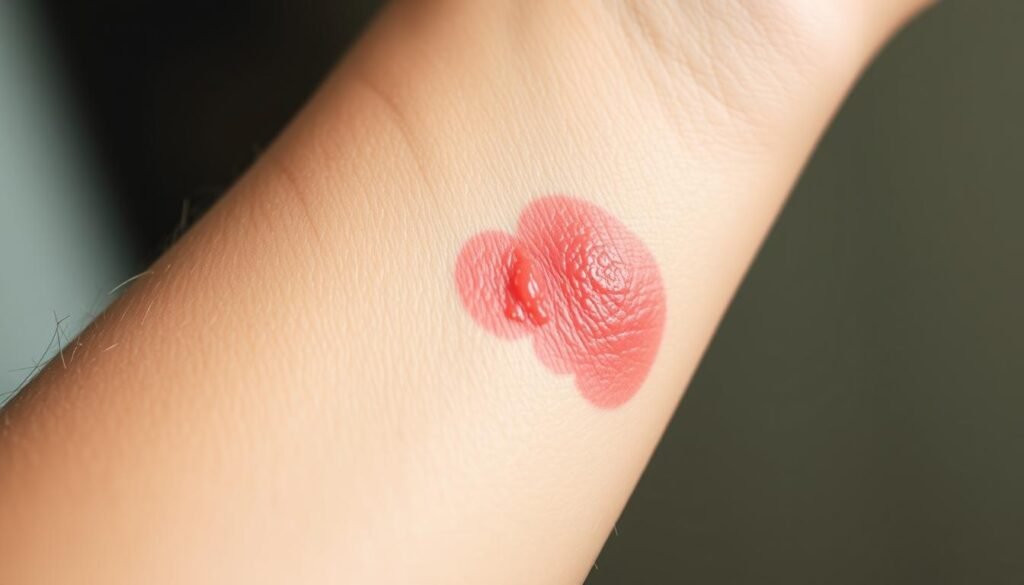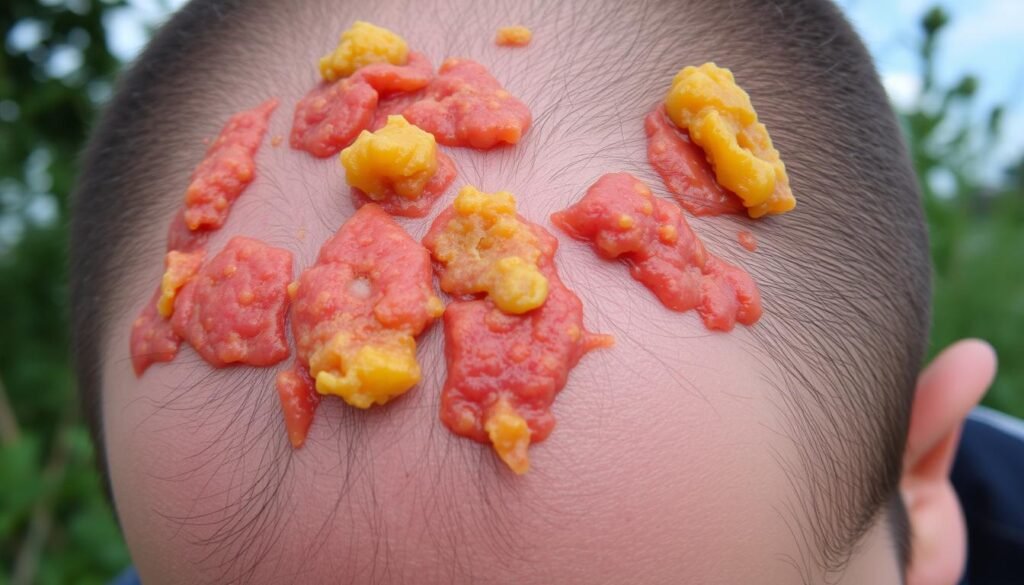Over 31 million Americans struggle with eczema. This skin issue can cause dry, itchy, and scaly skin, leading to discomfort. One common type is atopic dermatitis, which usually starts in young kids but can affect anyone. It’s important to know about different types such as contact dermatitis, seborrheic dermatitis, dyshidrotic eczema, neurodermatitis, nummular eczema, and stasis dermatitis.
Symptoms can vary a lot. Some people might have more than one type. That’s why getting a professional diagnosis and treatment is key. We’ll look more into these eczema types. This will help you recognize signs, triggers, and treatments. For more about eczema, check out Healthline’s guide.
Key Takeaways
- Over 31 million Americans suffer from eczema, with atopic dermatitis being the most prevalent.
- Mild eczema types include contact dermatitis, seborrheic dermatitis, and dyshidrotic eczema among others.
- Understanding the symptoms and triggers of each eczema type is essential for management.
- Professional medical advice is crucial when symptoms persist or worsen.
- Effective treatments are available, but no known cure for eczema exists.
What is Eczema?
Eczema is a long-term skin issue marked by inflammation. It leads to symptoms like dry, cracked skin, itchiness, and visible rashes. This condition, though often tied with atopic dermatitis, includes various eczema types. It can start in childhood and affects different ages. Currently, about 31 million Americans deal with eczema.
The exact causes of eczema are still a mystery. They could be genetic, environmental, or due to skin barrier issues. If eczema or allergies run in your family, you might be more at risk. Often, symptoms show on the skin in bending areas, like behind knees and inside elbows.
Inflammation from eczema might increase your risk for food allergies, asthma, and frequent skin infections. Continuous scratching can make the skin very itchy. It may also lead to patches that are darker or lighter than your normal skin tone.
Getting to know the different eczema types helps in managing symptoms. Triggers vary by eczema type and can include cleaning products or allergens like dust and pollen. Recognizing what causes your flare-ups is key to prevention and easing eczema’s discomfort.
Overview of Mild Eczema Types
An overview of mild eczema reveals several types. Each has unique eczema symptoms and triggers. Knowing about these eczema varieties helps in managing them. Atopic dermatitis is the most common and often starts in childhood. It may last into adulthood, especially in families with allergy histories. Other forms are contact dermatitis, dyshidrotic eczema, neurodermatitis, nummular eczema, seborrheic dermatitis, and stasis dermatitis.
Contact dermatitis splits into allergic and irritant categories. Allergic contact dermatitis links to specific allergens. Irritant contact dermatitis causes skin pain and burning. Dyshidrotic eczema means small, fluid-filled blisters on hands and feet. Meanwhile, neurodermatitis creates itchy, raised patches anywhere on the body.
Nummular eczema makes round, coin-shaped patches, more common in those with dry skin. Understanding these types is important for finding the right care. Treatments like steroids and certain ointments can help. Seeing a dermatologist is best to figure out your eczema type and treatment. For more on atopic dermatitis, visit this resource.
| Eczema Type | Common Symptoms | Location of Lesions |
|---|---|---|
| Atopic Dermatitis | Itchy, dry skin; red patches | Often on the face, neck, and inside elbows |
| Contact Dermatitis | Redness, warmth; blisters | Exposed areas like hands and face |
| Dyshidrotic Eczema | Fluid-filled blisters | Hands and feet |
| Neurodermatitis | Raised, itchy patches | Arms, legs, and shoulders |
| Nummular Eczema | Coin-shaped itchy patches | Commonly on arms and legs |
| Seborrheic Dermatitis | Flaky, red skin; dandruff | Scalp, face, and upper back |
| Stasis Dermatitis | Swelling and redness | Lower legs |
Atopic Dermatitis
Atopic dermatitis, or eczema, is widespread in the U.S. It affects over 9.6 million kids and 16.5 million adults. This long-term skin issue usually starts in babies, often before they are six months old. Knowing its signs and what causes flare-ups is key to handling it well.
Symptoms of Atopic Dermatitis
Intense itching is the main sign of atopic dermatitis, bothering more than 85% of people with it every day. Other symptoms include:
- Dry, scaly patches
- Red or brownish-gray skin
- Cracking and crusting
- Blistering or bleeding
These signs often show up on the elbows, knees, hands, and face, mainly in babies and young kids. The disease isn’t just physically painful. It can also hurt emotionally, lowering life quality for those affected and their families.
Common Triggers
Figuring out what causes eczema flare-ups is vital. Common triggers are:
- Environmental allergens (dust mites, pet dander)
- Irritants (soaps, detergents)
- Heat and temperature changes
- Skin infections
- Stress and hormonal changes
Studies have found that some people with this skin condition might have a gene mutation. This affects their skin’s protective barrier. While there’s no cure for eczema, ongoing research brings hope. New treatments and lifestyle tips can help manage the condition better.
Contact Dermatitis
Contact dermatitis happens when skin meets certain irritants or allergens, causing different reactions. About 15% to 20% of people will experience it at some point. There are two types: irritant contact dermatitis and allergic contact dermatitis. Each has its unique characteristics and triggers.
Types of Contact Dermatitis
Irritant contact dermatitis makes up 80% of cases. It’s caused by harsh substances like soaps or chemicals damaging the skin directly. Symptoms like redness, swelling, and itching usually start right away.
Allergic contact dermatitis, however, comes from an immune reaction to allergens like nickel or fragrances. Symptoms can take a day or two to show up after touching the irritant or allergen.
Identifying Irritants and Allergens
Finding out the exact irritants and allergens is key to managing contact dermatitis. Dermatologists often use patch testing to identify the allergens. This step is especially critical for those in jobs like cleaning or hairstyling, where contact with irritants happens often. Sometimes, severe allergic reactions to contact dermatitis can even lead to a hospital stay. This shows how important it is to diagnose it quickly.

Dyshidrotic Eczema
Dyshidrotic eczema, or pompholyx, is a type of eczema with small, itchy blisters on the hands and feet. It causes significant discomfort and can last weeks. Knowing the symptoms and triggers helps manage it better.
Symptoms and Discomfort
People with this eczema may have:
- Small, fluid-filled blisters on hands and feet
- Intense itching and burning sensations
- Redness and inflammation around the blisters
- Thickened skin upon healing
The symptoms lead to a lot of discomfort, particularly during flare-ups. It’s important to know what causes your eczema to prevent it.
Potential Causes
The clear causes of this eczema are unknown, but triggers include:
- Allergies, especially to metals like nickel and cobalt
- Environmental factors such as dampness and heat
- Stress, which can make it worse
- Frequent hand wetting or exposure to irritants, often due to certain jobs
Many with dyshidrotic eczema also have a family history of skin conditions. Knowing these triggers can help manage symptoms and reduce flare-ups.
Neurodermatitis
Neurodermatitis is called lichen simplex chronicus by some. About 12% of people have it, often seen as one or two patches on the skin. It mostly affects adults between 30 to 50 years old, more so in women. Those with skin issues like contact dermatitis or atopic dermatitis are more likely to get it. Stress also plays a big role, leading to an itch-scratch cycle that worsens the condition and affects daily life.
Understanding the Itch-Scratch Cycle
The itch-scratch cycle starts with itching that makes a person scratch. This can irritate the skin more, causing thick and scaly patches. Caught in this cycle, scratching feels good momentarily but keeps the itch going and damages the skin more. Knowing about this cycle helps a lot in managing eczema better.
Management Strategies
Many strategies help manage neurodermatitis. Some treatments include:
- Corticosteroids to lessen inflammation
- Calcineurin inhibitors like tacrolimus
- Salicylic acid for softer skin
- Patches with lidocaine or capsaicin for less pain
- Antihistamines for less itching and better sleep
Treatments like TENS and UVA/UVB light therapy might help those with ongoing symptoms. Psychological help, including therapy or counseling, can lower anxiety that triggers the itch-scratch cycle. Yoga and mindfulness may also reduce the need to scratch by promoting relaxation.
Taking care of yourself is key. Using cool compresses, taking oatmeal baths, and keeping nails short can protect your skin. Wearing clothes that don’t irritate the skin is important too. It’s critical to treat neurodermatitis early to avoid further issues.
Nummular Eczema
Nummular eczema is known for causing itchy, coin-shaped spots on the skin. It often appears on the arms and legs. Mostly affecting older men and younger women, anyone with very dry or sensitive skin is at risk.
We don’t fully understand what causes nummular eczema. It’s often tied to having dry skin and can follow skin injuries. People with other eczema types are more likely to get it. Many have allergies that make things worse. A lot of times, simple treatments you buy without a prescription don’t really help.
Treatment usually involves several approaches, such as creams and medicine for the skin. If there’s an infection, antibiotics might be used. The itching can make it hard to sleep. This is why seeing a dermatologist is good. They can suggest the best treatments and ways to live that can control the eczema.
| Characteristic | Description |
|---|---|
| Appearance | Coin-shaped, itchy patches |
| Common Areas | Arms and legs |
| Type of Patients | More common in males |
| Associated Conditions | Dry skin, other types of eczema |
| Treatment Options | Moisturizers, topical steroids, antibiotics if infected |
Managing nummular eczema well can really improve life. Following a good skin care routine and getting a doctor’s advice are key. This helps lessen the symptoms.
Seborrheic Dermatitis
Seborrheic dermatitis is common, affecting 3–10% of adults. It’s often called scalp eczema. This condition leads to scaly patches and noticeable dandruff. It’s usually found on the scalp but can appear on the face, upper back, and in skin folds as well.
Symptoms and Affected Areas
Symptoms of seborrheic dermatitis include:
- Red, inflamed skin
- Oily, scaly patches
- Dandruff that may be yellowish or greasy
- Itchiness or discomfort in affected areas
The condition often shows up in oily areas, mainly on the scalp. It can also be found behind the ears, on the chest, and on the face. The severity of seborrheic dermatitis can change, with flare-ups and remission periods lasting years, especially in adults.
Associated Conditions and Triggers
Seborrheic dermatitis might occur alongside other medical issues, like psoriasis, depression, and Parkinson’s disease. Triggers include:
- Hormonal changes
- Stress and illness
- Harsh detergents and chemicals
- Cold, dry weather and seasonal shifts
Stress, oily skin, and genetics contribute to seborrheic dermatitis. However, it doesn’t cause hair loss. In 2023, the FDA approved Zoryve for treating it in people aged nine and up. It comes in foam and cream forms.

Stasis Dermatitis
Stasis dermatitis is mainly found in people over 50 with poor blood flow. It shows up as leg eczema, with itching, swelling, and skin color changes. More women get it than men. Things like varicose veins, high blood pressure, and being overweight can make you more likely to get it.
- Ankle swelling
- Orange-brown discoloration, likened to cayenne pepper spots
- Redness and intense itching
- Scaling and dryness
- A heavy or achy feeling in the legs
In severe cases, the skin can thicken and harden, looking like cobblestones. Treatment includes compression stockings and lifestyle changes, such as more exercise.
Recognizing stasis dermatitis early is key to managing it. This means less damage to the skin and dealing with health issues sooner. Doctors may use creams or antibiotics if the skin gets infected. Early action improves life for people with this condition.
Mild Eczema Types and Their Treatment Options
Mild eczema management uses different treatments based on the eczema type. The range includes moisturizers from the store to prescription drugs. These aim to ease symptoms well. Topical treatments like corticosteroids help lessen itchiness and inflamed skin fast.
Pimecrolimus cream and tacrolimus ointment are good alternatives to corticosteroids. New options like crisaborole ointment and ruxolitinib cream help those with mild to moderate atopic dermatitis. Sometimes, FDA-approved systemic treatments are needed. These include Dupilumab (Dupixent®), abrocitinib, and upadacitinib.
For harder to treat eczema, Tralokinumab-ldrm (Adbry™) offers a strong injectable option. Old systemic medications such as azathioprine and cyclosporine are still useful. Light therapy also shows promise, but it needs multiple sessions. This shows how vital personalized eczema treatment is.
Keeping a regular skincare routine helps manage mild eczema. Regularly using moisturizer and taking antihistamines to stop itching improves life quality. Home remedies and professional advice can lead to good outcomes.
It’s crucial for anyone with eczema to seek help from healthcare experts. For more on diagnosing and treating atopic dermatitis, check this resource.

Preventing Eczema Flare-Ups
Understanding how to stop eczema flare-ups is key. Triggers like irritants, allergens, and stress play a big part. They can cause uncomfortable flare-ups. So, knowing how to manage them is important for a good life. Keep your skin moisturized to deal with one of the biggest causes, dry skin.
Look out for certain ingredients in soaps, shampoos, and bubble baths as they may trigger allergies. It’s smart to read labels to steer clear of them. Irritants often found in cleaners and body washes should be avoided as well. Knowing what makes your skin react helps you make better choices every day.
Handling stress is crucial to stopping eczema from getting worse. Techniques to relax can stop the stress-and-itch cycle of eczema. Things like dust, smoke, and animal fur can also make it worse. Keeping your space clean and avoiding those triggers lowers your flare-up chances.
Knowing the early signs of a flare-up means you can act fast to soften its impact. If problems keep up, talking to a doctor is a wise step. They can guide you to treatments. The table below lists strategies to prevent flare-ups, with tips for keeping your skin healthy.
| Strategy | Description |
|---|---|
| Regular Moisturization | Use gentle, fragrance-free moisturizers to keep skin hydrated. |
| Avoiding Harsh Products | Select cleansers and detergents that are mild and free from irritants. |
| Managing Stress | Incorporate relaxation techniques like yoga or meditation into daily life. |
| Wearing Loose Clothing | Opt for soft, breathable fabrics to reduce skin irritation. |
| Using a Humidifier | Maintain optimal humidity levels in living spaces to combat dry air. |
| Customizing Shower Routines | Take shorter, lukewarm showers, avoiding long exposure to hot water. |
Conclusion
It’s crucial to understand different mild eczema types for good skin care. Each type has its own symptoms and triggers that need specific treatments. Knowing these can help people manage their eczema better.
Eczema is common, affecting up to 30% of children and 10% of adults. About 60% of cases start in babies. Though many children get better, some might develop asthma or allergies. Talking to a doctor for a custom treatment plan is vital.
Knowing what triggers eczema is key to reducing flare-ups. Being informed lets people handle their eczema better. This way, they can enjoy healthier skin and a better life.